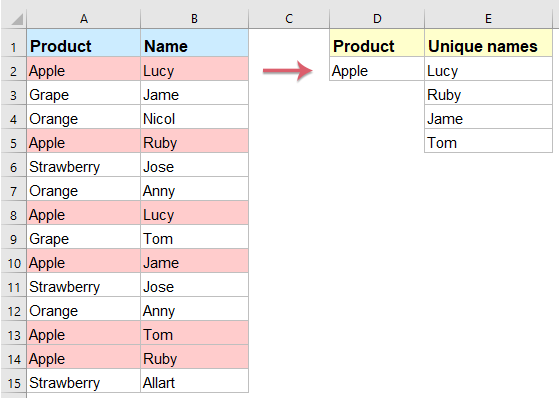วิธีแยกค่าที่ไม่ซ้ำตามเกณฑ์ใน Excel

สมมติว่าคุณมีช่วงข้อมูลด้านซ้ายที่คุณต้องการแสดงเฉพาะชื่อเฉพาะของคอลัมน์ B ตามเกณฑ์เฉพาะของคอลัมน์ A เพื่อให้ได้ผลลัพธ์ตามภาพด้านล่างที่แสดง คุณจะจัดการกับงานนี้ใน Excel อย่างรวดเร็วและง่ายดายได้อย่างไร?
แยกค่าที่ไม่ซ้ำกันตามเกณฑ์ด้วยสูตรอาร์เรย์
แยกค่าที่ไม่ซ้ำกันตามเกณฑ์หลายเกณฑ์ด้วยสูตรอาร์เรย์
ดึงค่าที่ไม่ซ้ำกันออกจากรายการเซลล์ด้วยคุณสมบัติที่มีประโยชน์
แยกค่าที่ไม่ซ้ำกันตามเกณฑ์ด้วยสูตรอาร์เรย์
ในการแก้ปัญหานี้คุณสามารถใช้สูตรอาร์เรย์ที่ซับซ้อนได้โปรดทำดังนี้:
1. ป้อนสูตรด้านล่างลงในเซลล์ว่างที่คุณต้องการแสดงรายการผลการแยกในตัวอย่างนี้ฉันจะใส่ลงในเซลล์ E2 จากนั้นกด Shift + Ctrl + Enter คีย์เพื่อรับค่าแรกที่ไม่ซ้ำกัน
2. จากนั้นลากที่จับเติมลงไปที่เซลล์จนกว่าเซลล์ว่างจะปรากฏขึ้นและตอนนี้ค่าที่ไม่ซ้ำกันทั้งหมดตามเกณฑ์เฉพาะได้รับการระบุไว้ดูภาพหน้าจอ:

แยกค่าที่ไม่ซ้ำกันตามเกณฑ์หลายเกณฑ์ด้วยสูตรอาร์เรย์
หากคุณต้องการแยกค่าที่ไม่ซ้ำกันตามเงื่อนไขสองเงื่อนไขนี่คือสูตรอาร์เรย์อื่นที่สามารถช่วยคุณได้โปรดทำดังนี้
1. ป้อนสูตรด้านล่างลงในเซลล์ว่างที่คุณต้องการแสดงรายการค่าที่ไม่ซ้ำกันในตัวอย่างนี้ฉันจะใส่ลงในเซลล์ G2 แล้วกด Shift + Ctrl + Enter คีย์เพื่อรับค่าแรกที่ไม่ซ้ำกัน
2. จากนั้นลากที่จับเติมลงไปที่เซลล์จนกว่าเซลล์ว่างจะปรากฏขึ้นและตอนนี้ค่าที่ไม่ซ้ำกันทั้งหมดตามเงื่อนไขสองเงื่อนไขที่ระบุได้รับการระบุไว้ดูภาพหน้าจอ:

ดึงค่าที่ไม่ซ้ำกันออกจากรายการเซลล์ด้วยคุณสมบัติที่มีประโยชน์
บางครั้งคุณแค่ต้องการดึงค่าที่ไม่ซ้ำกันออกจากรายการเซลล์ที่นี่ฉันจะแนะนำเครื่องมือที่มีประโยชน์ -Kutools สำหรับ Excelเดียวกันกับที่ แยกเซลล์ด้วยค่าที่ไม่ซ้ำกัน (รวมรายการที่ซ้ำกันครั้งแรก) ยูทิลิตี้คุณสามารถดึงค่าเฉพาะได้อย่างรวดเร็ว
หลังจากการติดตั้ง Kutools สำหรับ Excelโปรดทำตามนี้:
1. คลิกเซลล์ที่คุณต้องการให้ผลลัพธ์ออกมา (หมายเหตุ: อย่าคลิกเซลล์ในแถวแรก)
2. จากนั้นคลิก Kutools > ตัวช่วยสูตร > ตัวช่วยสูตรดูภาพหน้าจอ:

3. ใน ตัวช่วยสูตร โปรดดำเนินการดังต่อไปนี้:
- เลือก ข้อความ ตัวเลือกจาก สูตร ชนิดภาพเขียน รายการแบบหล่นลง
- จากนั้นเลือก แยกเซลล์ด้วยค่าที่ไม่ซ้ำกัน (รวมรายการที่ซ้ำกันครั้งแรก) จาก เลือก fromula กล่องรายการ;
- ทางด้านขวา การป้อนอาร์กิวเมนต์ เลือกรายการเซลล์ที่คุณต้องการแยกค่าที่ไม่ซ้ำกัน

4. จากนั้นคลิก Ok ผลลัพธ์แรกจะปรากฏในเซลล์จากนั้นเลือกเซลล์แล้วลากที่จับเติมไปยังเซลล์ที่คุณต้องการแสดงรายการค่าที่ไม่ซ้ำกันทั้งหมดจนกว่าเซลล์ว่างจะปรากฏขึ้นดูภาพหน้าจอ:

ดาวน์โหลด Kutools for Excel ได้ฟรีทันที!
บทความที่เกี่ยวข้องเพิ่มเติม:
- นับจำนวนค่าที่เป็นเอกลักษณ์และแตกต่างจากรายการ
- สมมติว่าคุณมีรายการค่าที่ยาวพร้อมกับรายการที่ซ้ำกันบางรายการตอนนี้คุณต้องการนับจำนวนค่าที่ไม่ซ้ำกัน (ค่าที่ปรากฏในรายการเพียงครั้งเดียว) หรือค่าที่ไม่ซ้ำกัน (ค่าที่แตกต่างกันทั้งหมดในรายการหมายความว่าไม่ซ้ำกัน ค่า + ค่าที่ซ้ำกันครั้งที่ 1) ในคอลัมน์ตามภาพหน้าจอด้านซ้ายที่แสดง บทความนี้ฉันจะพูดถึงวิธีจัดการกับงานนี้ใน Excel
- รวมค่าที่ไม่ซ้ำกันตามเกณฑ์ใน Excel
- ตัวอย่างเช่นฉันมีช่วงของข้อมูลที่มีคอลัมน์ชื่อและลำดับในขณะนี้เพื่อรวมเฉพาะค่าที่ไม่ซ้ำกันในคอลัมน์คำสั่งซื้อตามคอลัมน์ชื่อตามภาพหน้าจอต่อไปนี้ วิธีแก้ปัญหานี้อย่างรวดเร็วและง่ายดายใน Excel
- เปลี่ยนเซลล์ในคอลัมน์เดียวตามค่าที่ไม่ซ้ำกันในคอลัมน์อื่น
- สมมติว่าคุณมีช่วงข้อมูลที่มีสองคอลัมน์ตอนนี้คุณต้องการเปลี่ยนเซลล์ในคอลัมน์หนึ่งเป็นแถวแนวนอนตามค่าที่ไม่ซ้ำกันในคอลัมน์อื่นเพื่อให้ได้ผลลัพธ์ต่อไปนี้ คุณมีแนวคิดดีๆในการแก้ปัญหานี้ใน Excel หรือไม่?
- เชื่อมต่อค่าที่ไม่ซ้ำกันใน Excel
- ถ้าฉันมีรายการค่าที่ยาวซึ่งเติมด้วยข้อมูลที่ซ้ำกันบางค่าตอนนี้ฉันต้องการค้นหาเฉพาะค่าที่ไม่ซ้ำกันแล้วรวมเข้าด้วยกันเป็นเซลล์เดียว ฉันจะจัดการกับปัญหานี้อย่างรวดเร็วและง่ายดายใน Excel ได้อย่างไร
สุดยอดเครื่องมือเพิ่มผลผลิตในสำนักงาน
เพิ่มพูนทักษะ Excel ของคุณด้วย Kutools สำหรับ Excel และสัมผัสประสิทธิภาพอย่างที่ไม่เคยมีมาก่อน Kutools สำหรับ Excel เสนอคุณสมบัติขั้นสูงมากกว่า 300 รายการเพื่อเพิ่มประสิทธิภาพและประหยัดเวลา คลิกที่นี่เพื่อรับคุณสมบัติที่คุณต้องการมากที่สุด...

แท็บ Office นำอินเทอร์เฟซแบบแท็บมาที่ Office และทำให้งานของคุณง่ายขึ้นมาก
- เปิดใช้งานการแก้ไขและอ่านแบบแท็บใน Word, Excel, PowerPoint, ผู้จัดพิมพ์, Access, Visio และโครงการ
- เปิดและสร้างเอกสารหลายรายการในแท็บใหม่ของหน้าต่างเดียวกันแทนที่จะเป็นในหน้าต่างใหม่
- เพิ่มประสิทธิภาพการทำงานของคุณ 50% และลดการคลิกเมาส์หลายร้อยครั้งให้คุณทุกวัน!
